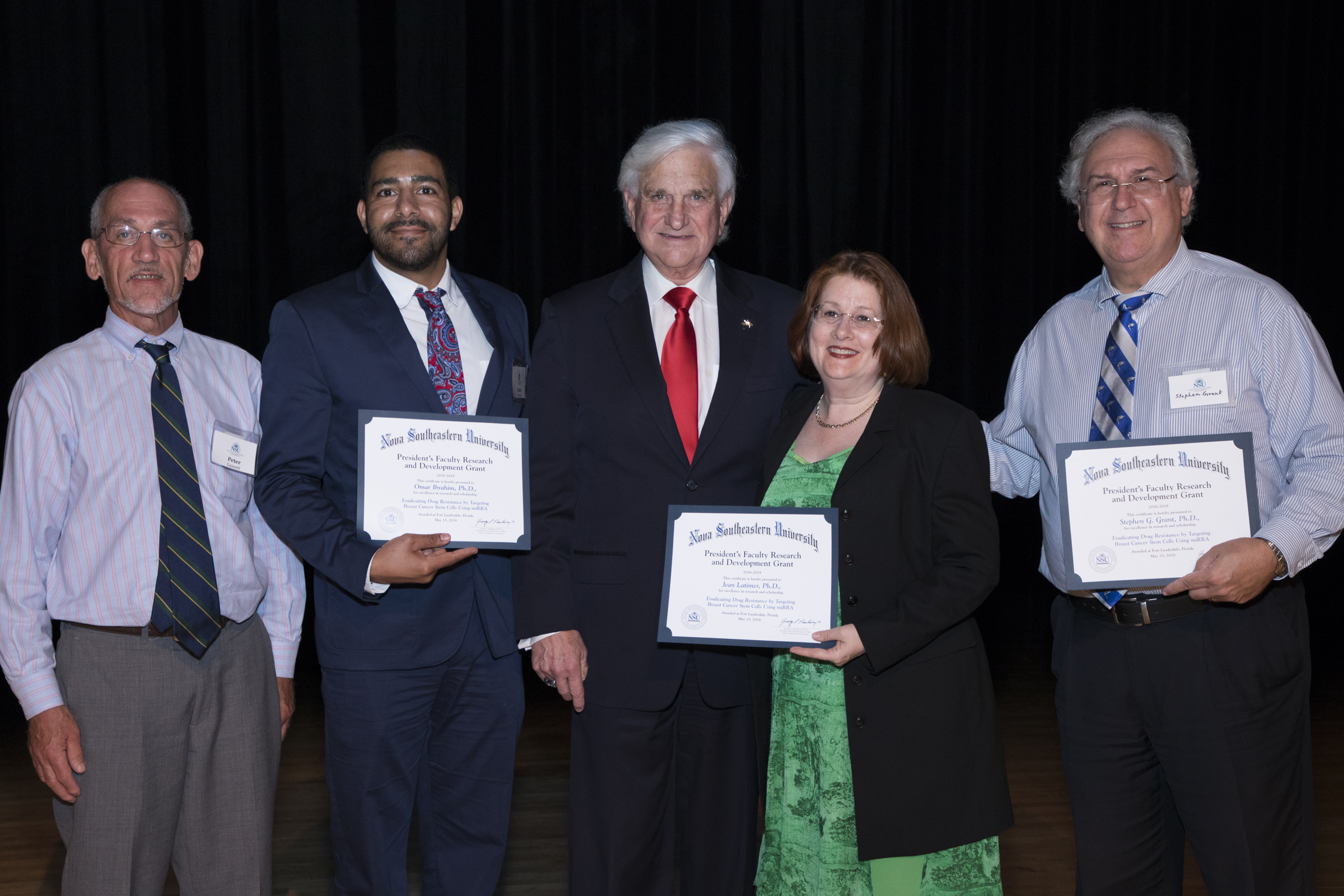Eradicating Drug Resistance by Targeting Breast Cancer Stem Cells Using miRRA
Grant Winners
- Jean Latimer, Ph.D. – College of Pharmacy
- Omar Ibrahim, Ph.D. – Translational Research and Economic Development
- Stephen G. Grant, Ph.D. – Dr. Kiran C. Patel College of Osteopathic Medicine
- Jowaher Sulieman A Alanazi, BS – College of Pharmacy
Deans
- Lisa Deziel, Pharm.D., Ph.D. – College of Pharmacy
- H. Thomas Temple, M.D. – Translational Research and Economic Development
Abstract

Treatment resistance in breast cancer is a major factor in recurrence and death. Nucleotide excision repair is a DNA repair pathway that repairs any damage that distorts the DNA helix or bulky adducts on the DNA. Our lab has previously shown that late-stage (stages III and IV) treatment-resistant breast cancer cell lines have increased nucleotide excision repair capacity, as measured by the unscheduled DNA synthesis assay when compared to early-stage (stages I and II). In addition, our lab discovered an increase in nucleotide excision repair capacity within the cancer stem cells isolated from these same late-stage cell lines. Therefore, the increased nucleotide excision repair capacity in the stem cell population of these cell lines drives the overall increased nucleotide excision repair capacity in the heterogeneous population. We have also shown that repair capacity can be modulated by short regulatory non-coding sequences of RNA, called miRNAs, that have been shown to have numerous effects in the regulation of resistance pathways and in cancer stem cell regulation. We have discovered an endogenous miRNA that is down-regulated in late stage cancers, and when restored can decrease expression of nucleotide excision repair genes and depress function. We have therefore termed this miRNA, miRNA resistance reducing agent (miRRA). We hypothesize that this miRNA will selectively reduce nucleotide excision repair gene expression in breast cancer stem cells as opposed to non-cancer stem cells, which already have lower repair ability. Furthermore, we expect that miRRA will also decrease nucleotide excision repair function as measured the unscheduled UDS assay in cancer stem cells preferentially over cancer non-stem cells. The use of miRRA will allow for better treatment efficacy by addressing two hallmarks of recurrence: resistance and cancer stem cell populations.
 Treatment resistance in breast cancer is a major factor in recurrence and death. Nucleotide excision repair is a DNA repair pathway that repairs any damage that distorts the DNA helix or bulky adducts on the DNA. Our lab has previously shown that late-stage (stages III and IV) treatment-resistant breast cancer cell lines have increased nucleotide excision repair capacity, as measured by the unscheduled DNA synthesis assay when compared to early-stage (stages I and II). In addition, our lab discovered an increase in nucleotide excision repair capacity within the cancer stem cells isolated from these same late-stage cell lines. Therefore, the increased nucleotide excision repair capacity in the stem cell population of these cell lines drives the overall increased nucleotide excision repair capacity in the heterogeneous population. We have also shown that repair capacity can be modulated by short regulatory non-coding sequences of RNA, called miRNAs, that have been shown to have numerous effects in the regulation of resistance pathways and in cancer stem cell regulation. We have discovered an endogenous miRNA that is down-regulated in late stage cancers, and when restored can decrease expression of nucleotide excision repair genes and depress function. We have therefore termed this miRNA, miRNA resistance reducing agent (miRRA). We hypothesize that this miRNA will selectively reduce nucleotide excision repair gene expression in breast cancer stem cells as opposed to non-cancer stem cells, which already have lower repair ability. Furthermore, we expect that miRRA will also decrease nucleotide excision repair function as measured the unscheduled UDS assay in cancer stem cells preferentially over cancer non-stem cells. The use of miRRA will allow for better treatment efficacy by addressing two hallmarks of recurrence: resistance and cancer stem cell populations.
Treatment resistance in breast cancer is a major factor in recurrence and death. Nucleotide excision repair is a DNA repair pathway that repairs any damage that distorts the DNA helix or bulky adducts on the DNA. Our lab has previously shown that late-stage (stages III and IV) treatment-resistant breast cancer cell lines have increased nucleotide excision repair capacity, as measured by the unscheduled DNA synthesis assay when compared to early-stage (stages I and II). In addition, our lab discovered an increase in nucleotide excision repair capacity within the cancer stem cells isolated from these same late-stage cell lines. Therefore, the increased nucleotide excision repair capacity in the stem cell population of these cell lines drives the overall increased nucleotide excision repair capacity in the heterogeneous population. We have also shown that repair capacity can be modulated by short regulatory non-coding sequences of RNA, called miRNAs, that have been shown to have numerous effects in the regulation of resistance pathways and in cancer stem cell regulation. We have discovered an endogenous miRNA that is down-regulated in late stage cancers, and when restored can decrease expression of nucleotide excision repair genes and depress function. We have therefore termed this miRNA, miRNA resistance reducing agent (miRRA). We hypothesize that this miRNA will selectively reduce nucleotide excision repair gene expression in breast cancer stem cells as opposed to non-cancer stem cells, which already have lower repair ability. Furthermore, we expect that miRRA will also decrease nucleotide excision repair function as measured the unscheduled UDS assay in cancer stem cells preferentially over cancer non-stem cells. The use of miRRA will allow for better treatment efficacy by addressing two hallmarks of recurrence: resistance and cancer stem cell populations.